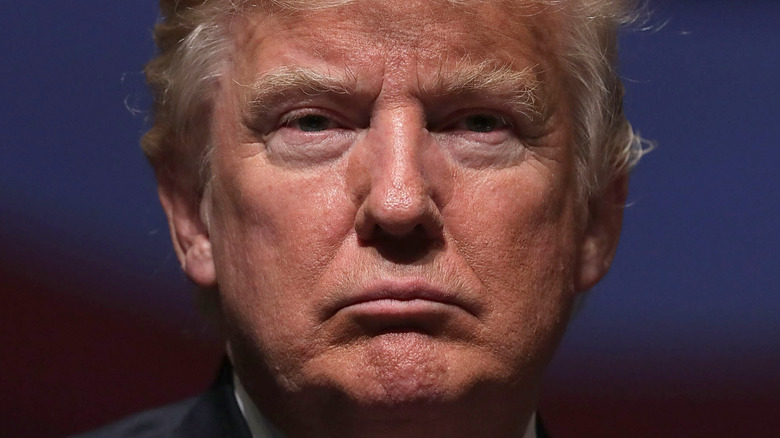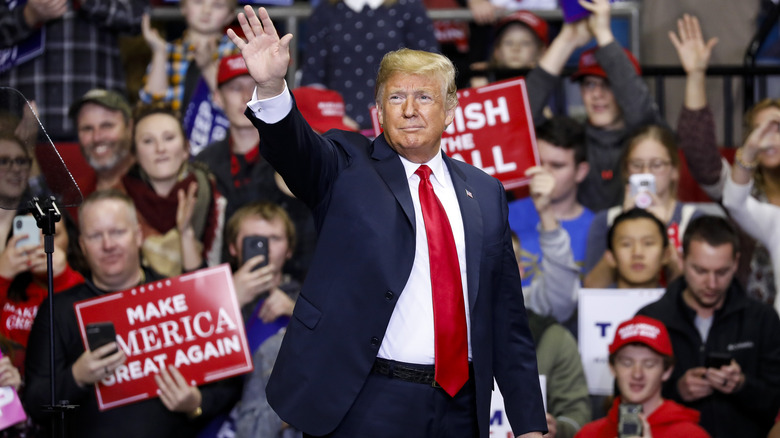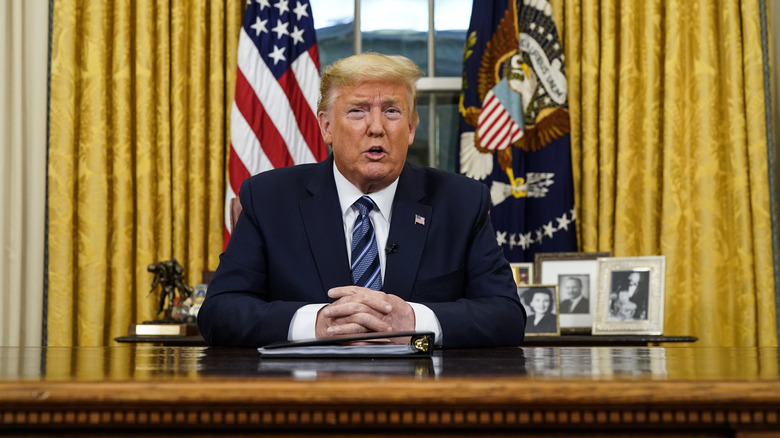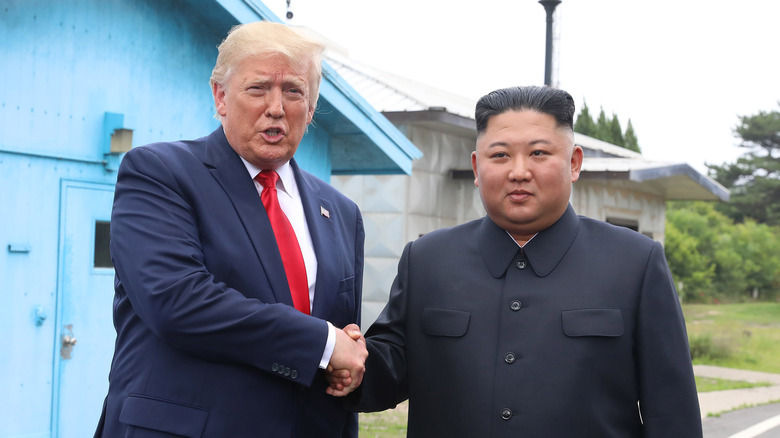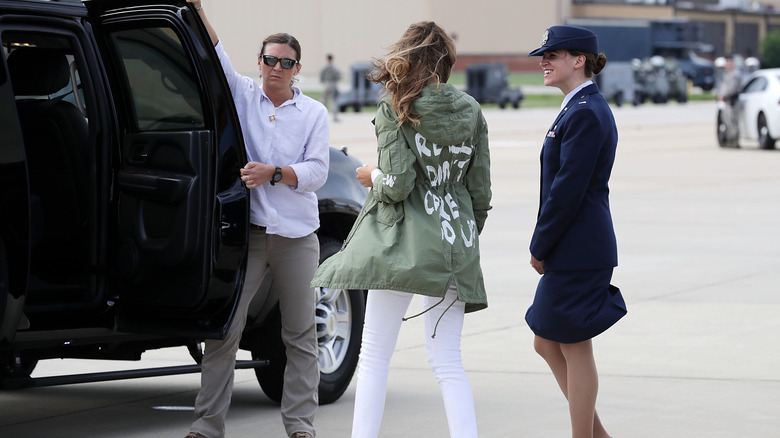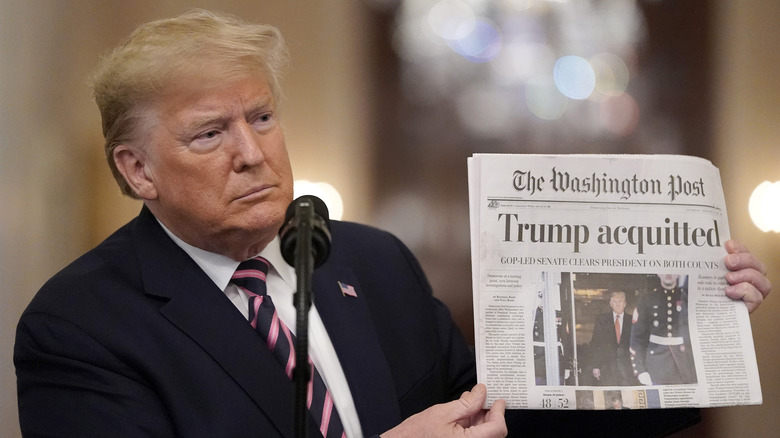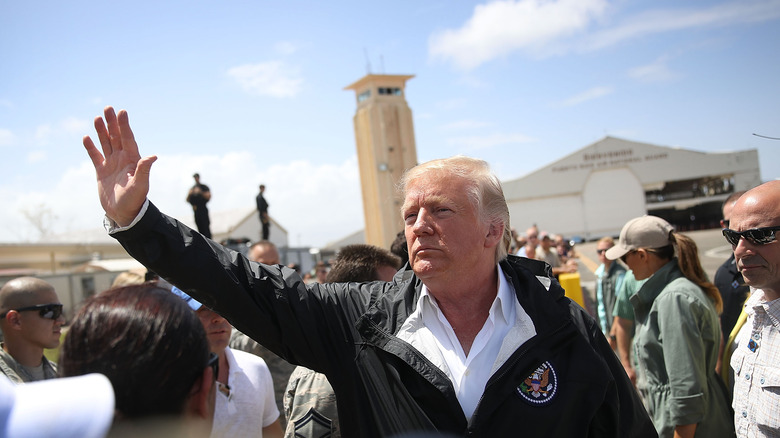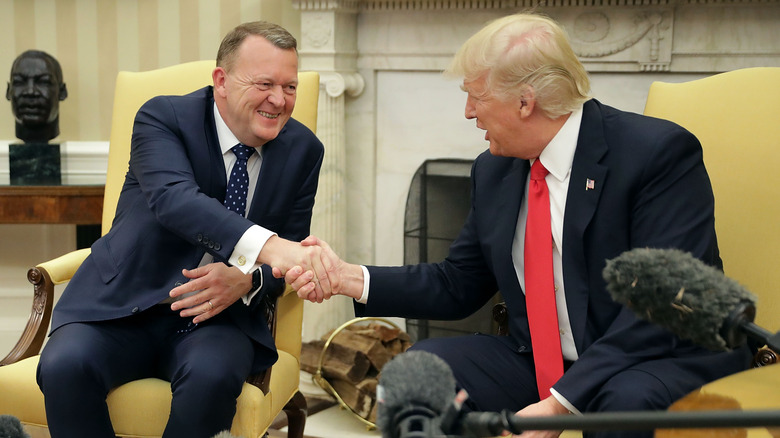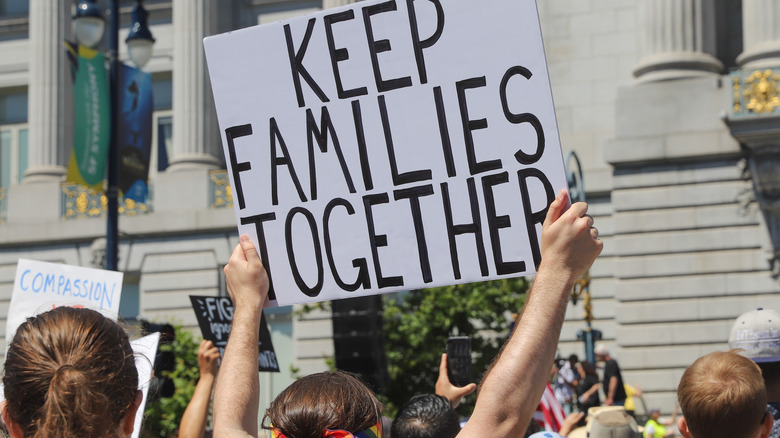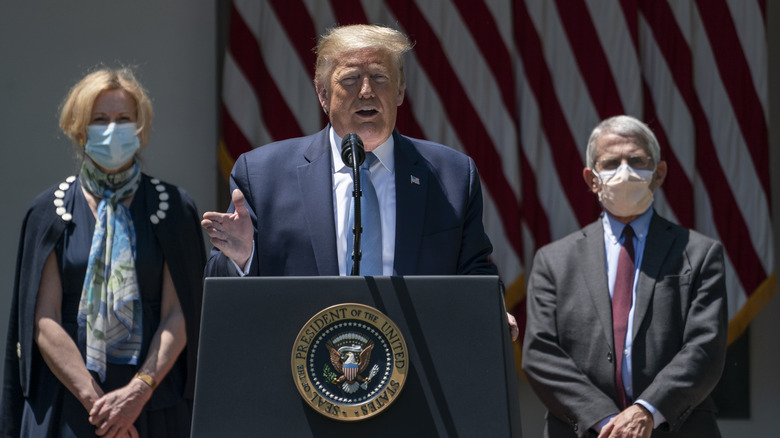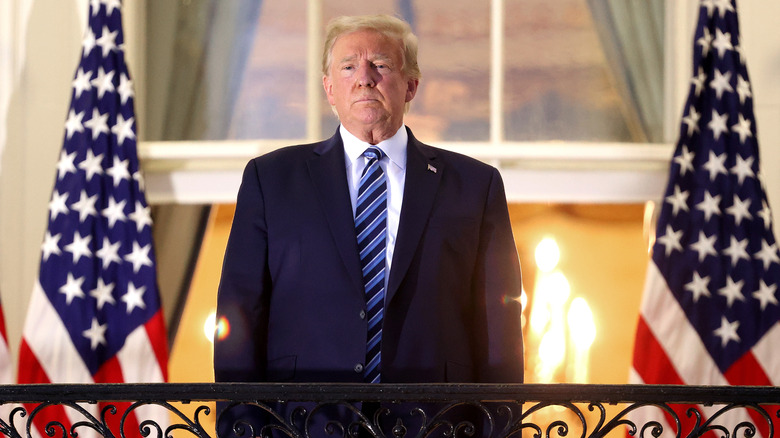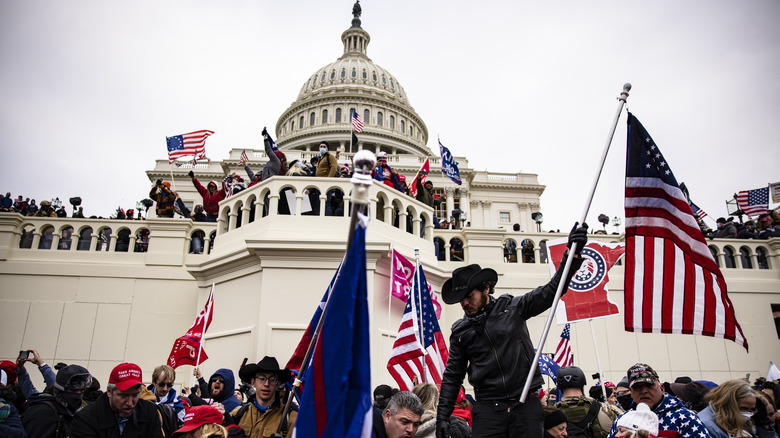Moments In Donald Trump's Presidency No One Will Forget
Donald Trump's presidency was a rollercoaster ride of scandals, lies, and impeachment hearings. But one of the Republican's most blatantly false claims happened only days into his term, when the former president insisted that the audience for his inauguration was bigger than Barack Obama's.
"I turn on one of the networks, and they show an empty field. I'm like, wait a minute," Trump objected at a CIA speech (via Vox), criticizing the media's estimate that only 250,000 people had attended. "It's a lie. We had 250,000 people literally around in the little ball we constructed," he insisted. "I made a speech. I looked out, the field was, it looked like a million, million and a half people."
Photographs of the crowd looked unflatteringly sparse, however, compared to the 1.8 million people who showed up for Obama's inauguration. When they kept being compared online (according to The Guardian), Trump decided to take action. He requested a new version of the photos the next day, and as a communications official recalled, the implication was that they had to be edited. Trump reportedly "wanted to see pictures that appeared to depict more spectators in the crowd."
So while the new president was being protested by hundreds of thousands of women, per The New York Times, his team was strategically cropping pictures of his crowds. Keep reading for more outrageous moments from 45 and his administration.
He called the Proud Boys 'very fine people'
One of the first shocking moments in Donald Trump's presidency came after a white supremacist "Unite the Right" rally in Charlottesville ended in three deaths.
As Vox reported, the 2017 rally had been organized in response to the impending removal of a Charlottesville statue of Confederate general Robert E. Lee. There had already been two protests about the statue, led by white supremacist figurehead Richard Spencer and the Ku Klux Klan, and police expected similar groups to show up in August. The man who actually filed the permits so that the demonstration could go ahead, Jason Kessler, championed "pro-white advocacy." So when an admitted white supremacist drove his car into a crowd of counter-protesters and killed a woman, as The Washington Post reported, the nature of this rally should have been clear.
The president felt the need to protect the white supremacist groups who appeared in Charlottesville, however. Trump condemned "hatred, bigotry and violence," per Politico, but claimed there were "very fine people on both sides." He also insisted that there had been an "alt-left that came charging at the, as you say, the alt right," claiming that the counter-protesters who had been hit by a car were "very, very violent" in the first place. "I've condemned neo-Nazis. I've condemned many different groups, but not all of those people were neo-Nazis, believe me," the president argued. "Not all of those people were white supremacists by any stretch."
He introduced the 'Muslim ban'
During his campaign, Donald Trump controversially stated that there should be "a total and complete shutdown of Muslims entering the United States until our country's representatives can figure out what is going on," as CNBC reported. Following an outcry about his Islamophobia, the Republican later clarified that he meant Muslims "from any nation that has been compromised by terrorism" (per CNN), insisting that it was a question of territory.
On January 27, 2017, he lived up to his promise by signing an executive order that caused chaos in airports across the United States for days. Trump's order "banned foreign nationals from seven predominantly Muslim countries from visiting the country for 90 days, suspended entry to the country of all Syrian refugees indefinitely, and prohibited any other refugees from coming into the country for 120 days," as the ACLU summarized. Since the First Amendment guarantees freedom of religion, many were quick to call this so-called "Muslim ban" unconstitutional.
A federal judge in Seattle temporarily prevented the order from being passed nationwide. According to NPR, however, around 60,000 visas were already revoked by the time Judge James Robart managed to halt the process in federal court.
He threatened to 'totally destroy' North Korea
Donald Trump's contentious relationship with North Korea was one of the most dramatic aspects of his foreign policy.
In his first-ever speech to the UN, he referred to leader Kim Jong-Un as "Rocket Man," emphasizing the danger of North Korea's "pursuit of nuclear weapons and ballistic missiles" and criticizing "the depraved regime in North Korea." "The United States has great strength and patience, but if it is forced to defend itself or its allies, we will have no choice but to totally destroy North Korea," Trump warned, before eventually assuring his audience that "hopefully this will not be necessary." He also called on the rest of the United Nations to back him up.
Although North Korea kept testing its nuclear capabilities, Trump began talks with the country's leaders and organized a peace summit in 2019. As CNN reported, he even became the first U.S. President to step into North Korean territory while meeting with Kim Jong-Un. James Clapper, former Director of National Intelligence, called the meeting "a great historic moment," even if the summit didn't lead to any concrete promises of denuclearization.
Melania's controversial coat
Some Americans never particularly warmed to Melania Trump in the role of first lady. According to a poll by CNN/SSRS, she left the White House with the lowest approval ratings of any president's wife: 47% of people polled actually disapproved of Trump. And she achieved that historically unfavorable rating through incidents like 2018's jacket-gate.
In June 2018, the first lady was criticized for wearing a green Zara jacket to visit a child detention center; the coat read, "I Really Don't Care, Do U?" As The Guardian reported, many thought that she was displaying a chilling lack of empathy toward refugee children who had been separated from their families by Donald Trump's administration. Both the president and the first lady responded. Donald Trump tweeted at the time: "'I REALLY DON'T CARE, DO U?' written on the back of Melania's jacket, refers to the Fake News Media. Melania has learned how dishonest they are, and she truly no longer cares!"
"It's obvious I didn't wear the jacket for the children, I wore the jacket to go on the plane and off the plane," Melania Trump told ABC News, arguing that the press should have focused more on her actions than her clothing. "It was for the people and for the left-wing media who are criticizing me. And I want to show them that I don't care. You could criticize whatever you want to say... But it will not stop me to do what I feel is right."
He was impeached by Congress
Only three American presidents have ever been impeached. It's a very rare outcome — unless, of course, you're Donald Trump, who went through two impeachment trials in one presidential term.
In December 2019, Trump faced charges of "abuse of power and obstruction of Congress," after it was alleged that he had asked foreign powers to interfere in the 2020 election. The investigation had been sparked by a whistleblower, Alexander Vindman, who testified about a phone call where Trump had tried to pressure President Volodymyr Zelensky of Ukraine into investigating Joe Biden and his son. "I could hardly believe what I was hearing," Vindman later wrote in The Atlantic. He also noted, "The president was brazenly involving not only himself but also Attorney General Barr, as well as his personal attorney Giuliani, in a wholly improper effort to subvert U.S. foreign policy in order to game an election."
In the end, the Senate didn't reach the 67 votes it needed to convict Trump, per NPR: 48 senators supported a guilty verdict, as opposed to the 52 politicians who voted that he was innocent. Only one Republican, Mitt Romney, made history by breaking party ranks to vote against Trump. He told his fellow senators that he had been forced to stand up to the president's "grievously wrong" actions.
He abandoned Puerto Rico during Hurricane Maria
One of the most devastating natural disasters in recent history happened in 2017 when Hurricane Maria hit the Caribbean, causing death and devastation in Puerto Rico.
Donald Trump's administration was heavily criticized for its slow response at the time. According to The Guardian, the government delayed more than $20 billion "in relief to Puerto Rico" through red tape and restrictions. The mayor of San Juan, Carmen Yulín Cruz, made headlines when she addressed Trump in an emotionally charged press conference. "I am begging you. Begging anyone that can hear us to save us from dying," she told reporters (via Time). "If anybody out there is listening, we are dying. And you are killing us with the inefficiency."
The president hit back by tweeting about Cruz's "poor leadership," according to Politico, and claimed on Twitter that the mayor as well as "others in Puerto Rico ... want everything to be done for them." The Washington Post later uncovered that Trump had told officials he didn't want any money going to Puerto Rico, as he believed their leaders were corrupt. He eventually visited the island in October, but was criticized for his flippant comments. "I hate to tell you, Puerto Rico, but you've thrown our budget a little out of whack because we spent a lot of money on Puerto Rico," Trump joked to officials, per The Hill. "And that's fine. We saved a lot of lives."
He later claimed that he was "the best thing that ever happened" to Puerto Rico, as The New York Times reported.
He tried to buy Greenland
Donald Trump tried to bring his real estate background to the presidency in 2019 when he suggested that the United States should buy Greenland, which is a self-governing territory technically owned by Denmark. As he told reporters, per MSNBC, the president found the idea "strategically" "interesting." "It's just something we talked about," he said. "Denmark essentially owns it. We're very good allies with Denmark. We've protected Denmark like we protect large portions of the world, so the concept came up...but we'll talk to them a little bit. It's not number one on the burner."
The territory's Ministry of Foreign Affairs quickly shot down Trump's suggestion that he could organize "essentially...a large real estate deal," tweeting: "Greenland is rich in valuable resources such as minerals, the purest water and ice, fish stocks, seafood, renewable energy and is a new frontier for adventure tourism. We're open for business, not for sale." As the BBC reported, Trump was so offended by Danish prime minister Mette Frederiksen calling his suggestion "absurd" that he even canceled his upcoming trip to Denmark.
"I thought that the prime minister's statement that it was absurd, that it was an absurd idea was nasty," he commented.
He separated families at the border
One policy from Donald Trump's administration turned out to be particularly unpopular. In 2018, Jeff Sessions announced that children would be taken away from anyone crossing the southern border, a policy that led to a total of 4,368 kids being separated from their families, according to the Los Angeles Times. Pictures of children in cages soon caused outrage on social media, per AP News, and prompted comparisons to dog kennels. And, as The Guardian reported, the separations led to long-term trauma and PTSD.
Trump tried to deflect the negative attention by blaming the Democrats, per Time, insisting that they wouldn't negotiate over immigration law. "If the Democrats would sit down instead of obstructing, we could have something done very quickly — good of the children, good for the country, good for the world," the president claimed, stressing that he "hated" seeing children removed from their parents. "We have the worst immigration laws in the entire world... You see about child separation, you see what's going on there." Trump also claimed that the Democrats were responsible for changing the legislation. "That's their law," he added.
He told COVID-19 victims to inject bleach
When COVID-19 started shutting down the entire country in 2020, Donald Trump began giving briefings about the situation to the press. One particularly cringe-worthy moment happened in April of that year, when the president suggested that disinfectant could be a possible treatment.
After introducing scientific experts who talked about how surfaces could be sanitized with disinfectant, Trump decided to share his own thoughts. "So, supposing we hit the body with a tremendous — whether it's ultraviolet or just very powerful light — and I think you said that hasn't been checked, but you're going to test it," he mused, per NBC, adding that it might be possible to bring "the light inside the body" in some way. "And then I see the disinfectant, where it knocks it out in a minute. One minute. And is there a way we can do something like that, by injection inside or almost a cleaning?" the president asked, insisting that it would be "interesting" to try. "Because you see it gets in the lungs, and it does a tremendous number on the lungs."
Trump immediately faced criticism for his dangerous suggestion from around the world — and even from some of the people on stage with him. Dr. Deborah Birx, his response coordinator at the time, sat at the side and could only watch as her president shared misinformation, as she later told ABC. "I didn't know how to handle that episode," Birx admitted, revealing that she "still [thought] about it every day." "You can see how extraordinarily uncomfortable I was," she recalled.
He was hospitalized for COVID-19
During the last year of Donald Trump's presidency, COVID-19 overwhelmingly became America's biggest problem. And in October 2020, the virus reached the White House. As CNN reported, Trump and his wife Melania admitted they had tested positive only a few days after the president had mocked his rival Joe Biden for wearing a mask during their debate. The Trumps weren't the only high-profile Republicans who caught the virus: politicians like Chris Christie and KellyAnne Conway also shared their positive results, as well as numerous aides.
As The New York Times reported, the president received an experimental treatment produced by Regeneron at the Walter Reed Medical Center. Although his doctor remained cagey about the details of Trump's medical care at the time, per The Times, his oxygen did drop to the 80s and there was talk of putting him on a ventilator. Clearly, the Republican wanted to show his supporters that he was well as soon as possible: on October 5, he appeared maskless on the White House balcony to show that he was out of the hospital. "As your leader, I had to do that. I knew there's danger to it but I had to do it," Trump claimed in a video (via CNN), telling his followers not to fear the disease. "I stood out front. I led."
His followers stormed the Capitol building
Many of Donald Trump's supporters also refused to accept the results of the election, as the world saw on January 6, 2021, when a mob stormed the Capitol building.
The protestors behind the deadly riots later argued that Trump wanted them to stop the Senate from approving of Joe Biden's presidency. During his speech, the Republican had acknowledged their plans. "I know that everyone here will soon be marching over to the Capitol building to peacefully and patriotically make your voices heard," he had stated, per NPR. But Trump had also used more violent language, urging the crowd to "fight" for the result they wanted. "We fight. We fight like hell and if you don't fight like hell, you're not going to have a country anymore. ... So let's walk down Pennsylvania Avenue," he continued.
Even after news outlets had reported that the crowd had brought a noose for Mike Pence, the Republican didn't even call his vice president to make sure he was safe (per The Washington Post). Despite the shocking footage, Trump didn't seem in any rush to condemn his supporters. He tweeted that they should "remain peaceful" and released a video telling the crowd that he loved them but they should "go home," per the BBC. After it was announced that a woman had died, he called the crowd "great patriots" and blamed the violence on the election being "viciously stripped away" from them.
The ensuing violence was a bizarre end to Trump's presidency, and led to another first: he became the first president to ever be impeached twice.

